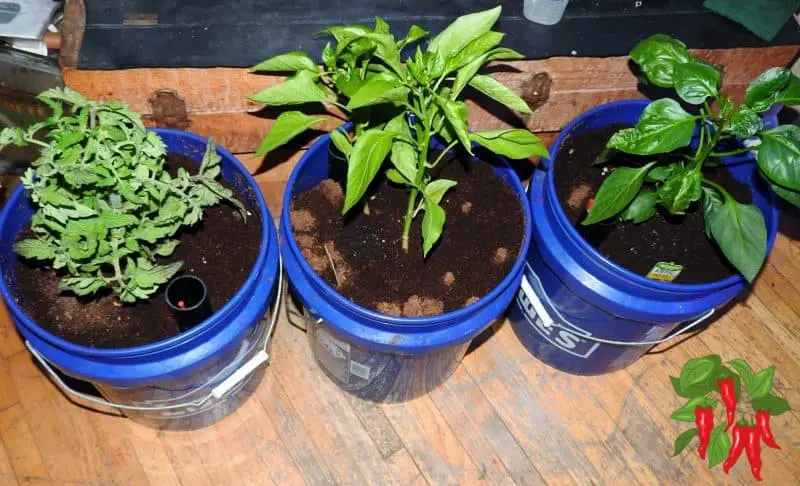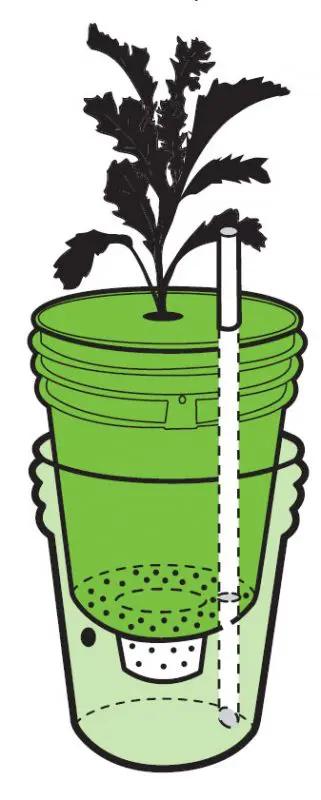This post contains affiliate links. If you buy something from one of our links we may earn a commission. Thanks

Do you want to create a sub-irrigated planter (SIP) but don’t know where to start and what the best sub-irrigated soil mix is to use?
Sub-Irrigated Planter Soil Key Takeaways:
- Sub-irrigated planter soil mix ensures optimal hydration and nutrition for plants.
- It should be a blend of potting mix and perlite, with an option to add organic matter.
- Coco coir, known for superior wicking properties, can also be used.
- Always pre-moisten the soil mix to activate its wicking capabilities before placing it in the SIP.
In this blog post, we will discuss everything you need to know about creating the perfect sub-irrigated planter soil mix.
We will go over what a sub-irrigated planter or SIP is and how it works and we’ll go over what type of soil to use, how much water to add, and which plants are best suited for SIPs. Let’s get started!
What Is A Sub-Irrigated Planter?

A sub-irrigated planter called a SIP for short is also known as a self-watering planter.
This is a type of pot that utilizes a reservoir system to deliver water directly to the roots of plants.
The reservoir is located below the plant, and it is connected to the soil via a series of small holes or slits or using wicks.
This allows the roots to absorb water as needed, without the risk of over-watering or drowning the plant.
In addition, sub-irrigated planters can also help to regulate the temperature of the root zone, creating a more ideal growing environment for plants.
SIPs eliminate daily watering and help stop over or underwatering plants.
For this reason, they are becoming very popular for home gardens. https://en.wikipedia.org/wiki/Sub-irrigated_planter
I use GroBuckets for my SIPs. They have an insert to keep the soil mix separate from the soil. They have a feed tube and a float so you know when they need more water. 
GroBuckets are not that expensive but you will need to provide your own buckets. The inserts work well and the float is handy so there is no guessing about when to add more water.
You will need to drill one hole for drainage. Other than that drop the insert in, attach the feed tube, and fill with the soil mix of your choice.
There are also plenty of DIY SIP tutorials if you want to make your own.
How Does A Sub-Irrigated Planter Work?
A sub-irrigated planter (SIP) is a type of container gardening system that uses a wicking mechanism to deliver water and nutrients directly to plant roots.
The plants are grown in a layer of growing medium, such as soil or coco coir, which is situated above a reservoir of water.
Sometimes a wick, made from a porous material such as polyester, extends from the reservoir up into the growing medium.
Some SIPs use a perforated barrier to hold the soil above the reservoir and capillary action moves the solution through the soil mix.
As the plants’ roots grow down toward the reservoir, they absorb water and nutrients from the soil.
SIPs will have a feed tube to add water to the reservoir. They water plants from the bottom up. Unlike regular planters, you normally don’t water them from the top.
The exception would be to water in a new transplant or to flush out the pot if you overfertilize or are getting a lot of salt build-up on top.
This type of watering system is ideal for plants that require consistent moisture levels, as it eliminates the need for frequent watering. It also helps to prevent root rot and other problems associated with overwatering.
Sub-Irrigated Planter Soil Mix
There are several soil mixes that work well for a sub-irrigated planter. The mix must have good wicking properties and allow for good aeration.
You can use any commercial peat-based potting mix but you will want to add additional perlite to the mix to lighten it up and help with drainage.
Coco coir is my preferred mix for SIPs. It has superior wicking properties and is much lighter than soil. It also has a naturally neutral pH while peat is quite acidic unless treated. You can use it with or without added perlite.
You can use hydroton or perlite alone too. But they will not provide as much moisture and are prone to salt build-up on top.
How Do You Mix Soil For Self-Watering Containers?
When it comes to growing healthy plants, the right soil mix is essential. While there are many different recipes out there, here is a basic guide on how to mix soil for self-watering planters.
Start with two parts potting mix and one part perlite. Add in some organic matter, such as compost or manure, for added nutrients. Finally, wet the soil thoroughly and allow it to drain before using it in your containers.
Alternatively use coco coir as your potting mix. You can add perlite to it if you wish but it really is not needed.
No matter what soil mix you use for a SIP it must be thoroughly wet before using it. If it is not, wicking or capillary action will be greatly limited. The whole soil profile needs to be moist for wicking to work correctly.
Self-watering containers are a great way to make sure your plants always have enough water. By mixing the right amount of soil, you can ensure that your plants will have access to the moisture they need without being overwatered.
SIPs are great for most houseplants and vegetables. Some plants like cacti or succulents like drier conditions and may develop root rot in self-watering pots.
How Do You Fertilize A Sub-Irrigated Planter?
Sub irrigated planters (SIPs) are a type of container gardening that utilizes a water reservoir to keep plants hydrated.
Because the roots of plants are constantly soaked in water, SIPs require a fertilization schedule that is different from traditional container gardening.
I recommend using a half-strength fertilizer solution to wet your soil before placing it in your container.
Remember that this soil must be premoistened already in advance or else your SIP will not work well.
Then the best way to fertilize a SIP is to mix the fertilizer into the water you add to your reservoir. This ensures that the roots come into contact with the nutrients they need without being overwhelmed.
It is important to remember that too much fertilizer can damage or even kill plants, so it is always better to err on the side of caution.
Your plants are being fed constantly in a SIP so you should use less fertilizer. I would start at half-strength and adjust accordingly.
Adding more fertilizer once a month should be sufficient for most plants, but you may need to adjust the frequency based on the needs of your particular plants.
 Also if you decide to use coco coir I would advise using nutrients designed for coco coir. It is a bit different from soil and needs more calcium and magnesium and less potassium than peat soil mixes.
Also if you decide to use coco coir I would advise using nutrients designed for coco coir. It is a bit different from soil and needs more calcium and magnesium and less potassium than peat soil mixes.
SIP FAQs
Delving deeper into the world of sub-irrigated planters, several questions arise regarding their creation, maintenance, and advantages.
As you plan your gardening endeavors, you might have a few queries in mind.
Below, we address some of the frequently asked questions about sub-irrigated planters to ensure you’re fully equipped for your gardening journey.
Q. What is the main advantage of using a Sub-Irrigated Planter?
A. The primary advantage of using a SIP is that it offers a consistent water supply to plant roots, reducing the risk of over-watering or under-watering.
This not only ensures optimal plant growth but also reduces the need for daily watering.
Q. How often should I water my SIP?
A. While SIPs reduce the frequency of watering, you should monitor the water level in the reservoir and refill it as needed.
Typically, you won’t need to water as often as with traditional pots, but the exact frequency depends on the plant type and environmental conditions.
Q. Can I use regular garden soil in my SIP?
A. While it’s possible to use garden soil, it’s recommended to use a mix of potting soil and perlite or coco coir.
These mixes ensure better wicking, aeration, and drainage which are essential for the SIP’s functionality.
Q. Are there any plants that aren’t suitable for SIPs?
A. Yes, plants that prefer drier conditions, such as cacti or some succulents, might not thrive in SIPs due to the consistent moisture levels.
It’s best to research the specific needs of your plants before placing them in a SIP.
Sub-Irrigated Planter Soil Mix Final Thoughts
As we wrap up this comprehensive exploration of sub-irrigated planters, it’s essential to revisit the key takeaways and their implications for gardening enthusiasts.
These planters are more than just a modern gardening trend; they signify a thoughtful evolution in the way we cater to our plants’ needs. Let’s crystallize our understanding with some final thoughts.
Sub irrigated planters (SIPs) offer many benefits to the home gardener including ease of use, minimal watering requirements, and fewer problems with pests and diseases.
Understanding SIP Benefits:
Sub-irrigated planters have reshaped the way many gardeners approach plant care.
By providing consistent moisture and reducing the risks associated with traditional watering methods, they simplify gardening tasks and increase the likelihood of lush, healthy plants.
Making Informed Choices:
While SIPs offer numerous advantages, understanding their nuances is essential.
From choosing the right soil mix to understanding the specific watering needs of each plant type, informed decisions will ensure your SIP gardening experience is both enjoyable and successful.
This guide provides helpful tips on how to create and care for sub-irrigated planters so that you can enjoy healthy plants all season long.
To sum up, sub-irrigated planters are a type of container gardening that utilizes a water reservoir to keep plants hydrated.
The soil mix for a SIP must be thoroughly wet before using it and the best way to fertilize a SIP is to mix the fertilizer into the water you add to your reservoir.
Remember that too much fertilizer can damage or even kill plants, so it is always better to err on the side of caution.
Sub-irrigated planters are a great way to make sure your plants always have enough water and by following these tips, you can create a thriving garden.
I hope this guide was helpful in understanding how sub-irrigated planters work and how to care for them.
By following the tips in this guide, you can create a beautiful and bountiful garden that will provide you with fresh fruits and vegetables all season long. Happy Gardening!





